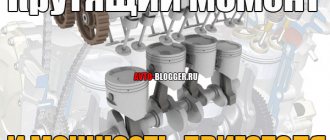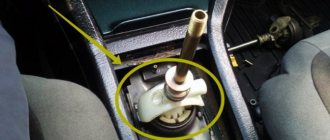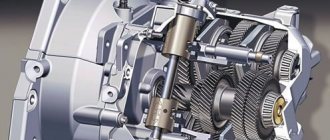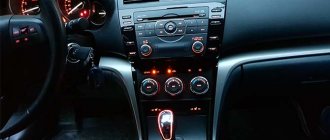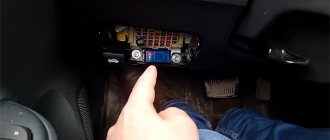What is an automatic transmission
Automatic transmission is a unit equipped with the ability to change speeds without human assistance. The main differences between an automatic transmission and a manual alternative are: the location of the gear lever and the number of pedals. Automatic transmissions require 2 pedals. This allows the driver to start driving without worrying about changing gears, which greatly simplifies the driving process.
The automatic transmission combines a torque converter and several planetary gears.
Thanks to the torque converter, the torque is doubled, ensuring smooth transmission without any vibrations. The torque converter is not directly connected to the main gear, so the car can be driven in tension in a high gear.
This becomes possible when power is reduced due to the difference in speed of the receiving turbine and pump wheel, as well as the continuous circulation of oil in the torque converter. Therefore, there is no connection between the engine and transmission, which makes it possible to stop the car with the gear engaged.
The main operating modes of the “automatic machine”:
There are also additional automatic transmission modes, which are used much less frequently.
Driving an automatic car
A car equipped with an automatic transmission does not allow the driver to accelerate sharply from a stop and spin wheels in mud or snow. Such situations often lead to overheating of the box, and, as a result, its fragility.
In the first couple of years, a beginner is recommended to learn all the basics of driving an automatic machine. There are a number of features of driving a machine on an “automatic” mode:
The principle of overtaking on such cars is exactly the same as on a manual one. To quickly accelerate, you need to press the gas pedal all the way, after which the transmission will engage a lower gear. This will give the car significant acceleration. Upon completion of the maneuver, release the pressure on the gas pedal, the “automatic” will switch to normal mode.
In traffic jams, driving an automatic transmission is not particularly difficult. The vehicle is held in place by pressing the brake.
In case of serious traffic jams, it is very difficult to keep your foot on the brake all the time, so experienced drivers advise periodically setting the “P” mode. If you start moving, you need to change the mode to “D” and hold down the brake pedal.
Starting a car with automatic transmission
To start the engine in a car with an automatic transmission, it is recommended to initially place the selector in the “P” position. It is also possible to start movement from the neutral position of the lever. The internal combustion engine cannot be started from any other position.
After setting the required lever position, apply the brake and then start the engine.
How to start automatically
Getting started correctly with an automatic transmission is not a very easy task for a novice driver. During their first driving lesson, students often make many mistakes when starting to drive.
Engine braking on automatic transmission
It turns out that on automatic transmissions, just like on manual ones, you can use engine braking.
Driving on long descents
If you have an "O/D"
you can press it, this will force the transmission to shift into third gear and cause gentle engine braking and will not allow the car to accelerate above
80 km/h
. This feature should not be used at speeds above 120 km/h.
Driving on steep slopes
Move the lever to position «2»
.
This will not allow your car to accelerate above 40-60 km/h
.
Off-road driving
If you are traveling off-road with very steep ascents and descents, move the gearbox to the “L”
, this will prevent the car from accelerating above
10-20 km/h
, and on ascents it will allow you to use the maximum torque from the engine.
Auto magazine AutoCool
Driving a car equipped with an automatic transmission (automatic gearbox) has its own characteristics, starting from the moment the engine starts until the moment it comes to a complete stop after driving and turning off the ignition. And although, in general, driving a car with an automatic transmission is more convenient, if you do not have driving skills with such a device, there are certain difficulties. Moreover, at all stages of movement.
But let's talk first of all about the moment of starting.
Brake pedal
Since a car equipped with an automatic transmission does not have a clutch pedal (it turns on automatically when the required engine torque is reached), movement begins after the brake pedal is released.
Factory engine settings allow you to start moving even without pressing the gas pedal after releasing the brake pedal. Gas is added to move to a higher transmission stage.
The brake pedal also regulates the speed when driving on roads during coasting descents from hills. In position P (parking), the hand brake does not need to be applied, since the wheel drive is in rigid coupling with the gears of the automatic transmission, and a very large external force is required for the car to move.
Gas pedal
The main feature of working with the gas pedal is that you also work with it with your right foot, just like with the brake pedal . Since there are no situations that require the simultaneous use of gas and brake (except for a launch start, more about which below).
"For
Those who have driven a car with a manual transmission in previous years have already developed certain skills and it will not be difficult to adapt to the new management. Most often, at first, after switching to a car with an automatic transmission, the driver’s confusion with the modes occurs at traffic lights: out of habit, the hand tries to switch the gearbox selector to “neutral”. Although to stop at a traffic light you just need to take your foot off the gas pedal and press the brake pedal.
Remember, when driving a car with an automatic transmission, your left leg is always at rest. All control occurs exclusively with the right hand.
What not to do with automatic transmission
Despite the fact that an automatic transmission seems easy to operate and is designed to make driving easier, there are still restrictions and prohibitions, adhering to which, the automatic transmission will last a long time and without complaints.
Restrictions and prohibitions when driving with an automatic transmission:
- Driving with a cold automatic transmission should be smooth, the first 6-10 km at low speed. It is necessary to warm up the automatic transmission even at positive ambient temperatures, and in sub-zero temperatures it should be warmed up for at least 10 minutes.
- A car with an automatic transmission is not designed to transport large loads, although a trailer can be used, but only a light one, and it is better to avoid towing other vehicles, except in emergency situations.
- Under no circumstances should you start a vehicle equipped with an automatic transmission from a pusher.
- It is permissible to turn off the engine only in the selector position “P”.
- When stopping for a short time (in a traffic jam, at a traffic light) to extend the life of the automatic transmission, it is not recommended to move the selector to “P” or “N”.
- While the vehicle is moving, under no circumstances should the selector be moved to the “R” and “P” positions.
- If it is necessary to stop on an inclined surface, the car must initially be secured using the parking brake, after which it is allowed to move the selector to the “P” position to avoid the selector leaving this position due to the significant load on the drive wheels.
- The “N” mode is intended only for towing vehicles to the repair site; under no circumstances should they be driven downhill in this mode.
Manufacturers have provided a long service life for automatic transmissions, but subject to certain rules.
If you do not adhere to them, then the time to repair the automatic transmission will get closer with each incorrect action. Repairing an automatic transmission is an expensive pleasure.
Getting started correctly with automatic transmission
In recent years, more and more cars are equipped with a START-STOP-Engine (SSE) button, which turns on the ignition and starts the engine. The system is advantageous in that it simultaneously serves as an anti-theft agent that responds to the car’s “native” electronic key: if it is not inside the car, the loop antenna in the doors will lock the locks and stop the engine.
The SSE system can be installed either factory-installed or independently.
Options for starting the engine with the SSE button:
The sequence of actions to set the car in motion will be as follows:
Now you can gradually release the brake pedal - the car will start moving even without boosting the engine with the gas pedal.
Be sure to watch the video for more details:
All automatic transmission modes
P (parking)
The car cannot be driven, but engine starting is allowed.
R (reverse)
The position at which reverse gear is engaged. Starting the engine in this mode is impossible. It is forbidden to turn on while moving forward - only after a preliminary stop!
D (drive, or movement)
Mode for starting off under standard conditions.
Activation of the second low-range gear for driving in terrain with elevation changes.
Range of low gears for off-road use. In this mode, only first gear is available.
Additional modes
Additional modes include mode 2 (only the first two gears are available), E (economical), S (sports), O/D (Over Drive) mode.
Let's take a closer look at them.
Mode E
When driving on flat terrain, the automatic program switches on a uniform motion mode with minimal fuel consumption.
Mode 2
The automatic locks the selection of all gears except 1st and 2nd. Used when towing or on winding mountain roads.
O/D mode
For quick acceleration of the car when overtaking or on a long climb. In this mode, a maximum of third gear is activated. It is turned on by a button located on the driving mode switch lever.
S mode
Active driving mode. When this mode is activated, the transition to higher gears is carried out at high engine speeds.
There are also modes “1”, “2” and “3”. In mode “1” only 1st gear works, in mode “2” (winter) 1st and 2nd, in mode “3” only 4th is not engaged. But modes 1,2 and 3 are not available on all automatic transmissions.
Video about automatic transmission modes:
Additional automatic transmission operating modes
On cars with an automatic transmission, there are additional controls, let's look at them:
OverDrive (O/D)
This button is found on gearboxes that have more than three gear levels. The button to turn on this mode is usually located on the gearbox lever. If the "O/D"
recessed, then the use of fourth gear is allowed.
If you press it, the “O/D OFF”
, which will mean that you have activated this mode.
Designed for overtaking other cars or other times when you need quick acceleration. Its effect is that it prevents the box from shifting above third gear, which ensures rapid acceleration.
"O/D OFF" mode
used during long climbs, when the engine begins to lack traction and the gearbox begins to “throw” between third and fourth gear.
Kick down
This mode is activated by a sharp
pressing the gas pedal. In this case, the box automatically shifts down one or two gears, which provides sharp acceleration. Upshifting in this mode occurs at significantly higher engine speeds compared to normal acceleration. It is not recommended to use this mode for sharp acceleration from a standstill, as this puts a very large load on the gearbox mechanism. It’s better to first let the car accelerate to at least 20 km/h, and then you can “gas to the floor.”
PWR/SPORT
This is a program mode that is designed for active driving. Shifting occurs at higher speeds, which ensures fast acceleration. However, fuel consumption in this mode is maximum.
SNOW
This is a program mode that is designed for driving in winter. In this mode, first gear is not engaged, acceleration begins immediately from second gear, which reduces the likelihood of slipping of the drive wheels. Also in this mode, switching occurs at lower speeds, which makes the car seem “sluggish”, but provides greater driving safety in the snow. Some people also use this mode in the summer, since fuel consumption in this mode is minimal. However, I would not recommend doing this, since in this mode the first gear is disabled, and therefore all the loads fall on the torque converter, which actively heats up. In winter this is normal for him, but in summer it can lead to overheating and possible breakdown of the automatic transmission.
Stop on the rise
The algorithm for applying the brakes on a hill is described in any operating instructions. But this process is rarely properly detailed, much less explained. We will try to bridge this gap.
Both the engine and the gearbox in the car are suspended on special support cushions-dampers. If the automatic transmission lever is first put on P and then the parking brake, then, rolling down the slope under the influence of its own weight, the car loads the transmission, forcing it to rest on one or two support pads. The result is the failure of these pillows, and as a result, the appearance of varying degrees of vibration.
When parking a car on the side of the road, regardless of whether the parking is on a descent or on an ascent, the wheels must be turned so that in case of spontaneous rolling, the car will slide in the direction opposite to the roadway.
Third place - slipping with automatic transmission
I already have a detailed article (it’s interesting to read). Slipping is a very negative phenomenon for an automatic machine. No, of course, there are reinforced structures (for example, on SUVs, where there are transfer cases and low gears), but in ordinary cars , this is not the case. And skidding too much is not right!
You must be guided by your head:
If your car is slipping, but there is progress that it will get out on its own, then you can try and get out of the skid - this can be said not to be slipping.
If your car sits on the bottom and spins its wheels helplessly , and you are constantly accelerating, THIS CAN’T BE DONE! Otherwise, you will simply overheat the automatic transmission and it will fail very quickly.
Some foreign cars even have “fool protection”, which prevents you from overheating the automatic transmission when slipping; a critical heating icon will appear on your dashboard, and the transmission will turn off until the car has cooled down.
Automatic launch start
This is a start using two pedals at the same time - brake and gas. Used for starting from a traffic light or when measuring speeds up to 100 km/h for a certain time.
This mode “stresses” the gearbox, so using it often is strictly not recommended. Only in extreme conditions and with good reaction and extensive driving experience.
The essence of the method is that the brake pedal is simultaneously pressed with the left foot (and this is the only case in driving a car with an automatic transmission when the left foot is used), and the gas pedal is pressed slightly with the right - until the engine speed reaches approximately 2000-2500 per minute. When this number of revolutions is reached, the brake is sharply released and gas is added at the same time.
The time difference with a normal start of up to 100 km/h can reach one and a half seconds - which is very noticeable.
Launch starts can be fatal for:
What saves the automatic transmission in this mode is that the shock loads on the engine and gearbox are damped by the torque converter.
* Damper (German Dämpfer - muffler, shock absorber from German dämpfen - dampen) - a device for damping (damping) or preventing vibrations that occur in machines, devices, systems or structures during their operation. more details on Wikipedia >>
Fifth place – start, with two pedals
There is such a thing as “two-pedal start” (also called “launch control”). When you hold the brake with one foot, press the gas with the other, raise the speed - then sharply release the brake pedal, and the car slips forward.
The point of such an activity is to “start” faster on the machine. Because the speed is high (4 - 5,000), the torque converter rotates decently. On turbocharged engines, the turbine also begins to pump up pressure to its fullest. And as a result, a sharp start and a gain of about a second.
YES this is important when you are fighting with someone, starting from a standing start. BUT for an automatic transmission this is a VERY heavy load.
The torque from the engine is sharply transferred to the transmission (in particular the gearbox), the load goes to the clutch packs and gears. All this really wears them out. So I don't advise you to start with two pedals often.
YES, and the meaning of “LAUNCH CONTROL” is on turbocharged engines, so that the turbine spins up. ON conventional aspirated engines , the increase in time is not large, from 0.2 to 0.4 seconds (also not small, but much less than on a turbo).
